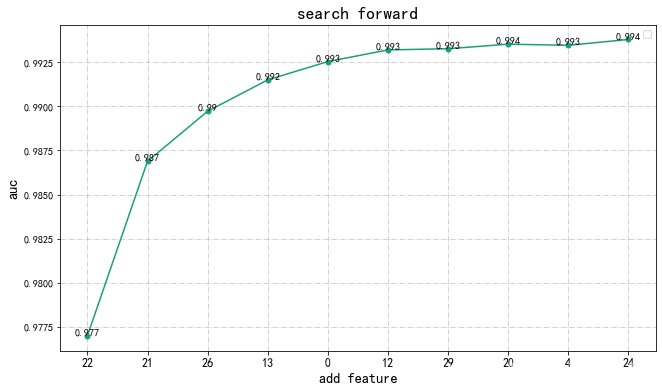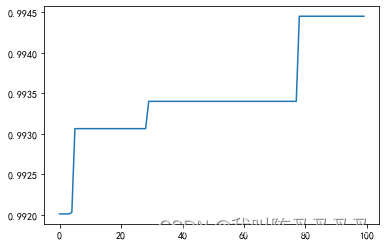一、简介
1、对特征选择的指标提供计算方法和代码,包括有:相关系数、互信息、KS、IV、L1正则化、单特征模型评分、特征重要度或系数大小、boruta特征评价、递归特征消除排序。
2、提供特征选择的方法和代码:前向搜索法、遗传算法启发式搜索法,最佳特征检测法,
# 本次项目使用的数据为以下数据,
from sklearn.datasets import load_breast_cancer
data = load_breast_cancer()
data['data'].shape
X,y= data['data'],data.target
# 模型使用的逻辑回归,评价指标为auc值,使用代码为封装的Feature_select类,代码附后
from tools.feature_select import Feature_select
fs = Feature_select(X,y,lr)
二、特征选择指标
1.皮尔森相关系数
Pearson相关系数反应了特征和标签之间的线性关系,其一个明显缺陷是,作为特征排序机制,他只对线性关系敏感。如果关系是非线性的,即便两个变量具有一一对应的关系,Pearson相关性也可能会接近0。
fs.corr()
array([-0.73002851, -0.4151853 , -0.74263553, -0.70898384, -0.35855997,
-0.59653368, -0.69635971, -0.77661384, -0.33049855, 0.0128376 ,
-0.56713382, 0.00830333, -0.5561407 , -0.54823594, 0.06701601,
-0.29299924, -0.25372977, -0.40804233, 0.00652176, -0.07797242,
-0.77645378, -0.45690282, -0.78291414, -0.73382503, -0.42146486,
-0.59099824, -0.65961021, -0.79356602, -0.41629431, -0.32387219])
2.互信息
相比皮尔森相关系数 ,互信息能够一定程度反应特征和标签之间的非线性关系。
fs.mic()
array([0.36671567, 0.09648092, 0.40428514, 0.35976973, 0.08173721,
0.21061423, 0.37479754, 0.44305847, 0.06671437, 0.01354967,
0.24521911, 0.00110187, 0.278233 , 0.33920662, 0.01602095,
0.07457715, 0.11807899, 0.12371226, 0.013367 , 0.04097258,
0.44985384, 0.12364186, 0.47728208, 0.46426447, 0.10166035,
0.22460362, 0.31435137, 0.43651194, 0.09544855, 0.06837461])
3.KS和IV值
KS和IV值作为风控中经常使用的两个指标,IV值更加注重特征对标签的区分能力,KS值注重模型对于标签的区分
fs.ks_iv()
(array([0.72390466, 0.45248666, 0.74467523, 0.73142276, 0.31537709,
0.57175889, 0.75971143, 0.81985624, 0.30314201, 0.05657735,
0.6018313 , 0.08626658, 0.5867951 , 0.70708472, 0.02433804,
0.37730564, 0.48077533, 0.45248666, 0.00573437, 0.2043893 ,
0.79730194, 0.44318482, 0.82737435, 0.80482004, 0.40636066,
0.54920459, 0.70058401, 0.80290418, 0.33869774, 0.29537287]),
array([3.78395724, 1.5824873 , 3.82087721, 3.82234285, 1.34695804,
2.10298612, 3.00830869, 3.9745556 , 1.31276152, 1.15309762,
2.53434592, 1.06847433, 2.80319049, 3.65151974, 1.06348267,
1.39990837, 1.61294779, 1.59034111, 1.06672724, 1.14612131,
4.44837968, 1.54256612, 4.58499352, 4.39469498, 1.48978388,
2.19735313, 2.57167549, 4.37557075, 1.63321251, 1.33836142]))
4.L1正则化
L1正则化将系数w的l1范数作为惩罚项加到损失函数上,由于正则项非零,这就迫使那些弱的特征所对应的系数变成0。因此L1正则化往往会使学到的模型很稀疏(系数w经常为0),这个特性使得L1正则化成为一种很好的特征选择方法。
这里采用sklearn总lasso模型进行封装
fs.l1_select(alpha=0.01) # alpha 系数越大,系数为0的特征越多
array([ 0. , 0.00202185, 0. , 0.00043358, -0. ,
-0. , -0. , -0. , -0. , -0. ,
-0. , -0. , -0. , -0.00125443, -0. ,
-0. , -0. , -0. , -0. , -0. ,
-0.08225553, -0.01460497, -0.01379535, 0.0007448 , -0. ,
-0. , -0.06013473, -0. , -0. , -0. ])
5.基于学习模型的特征评分
这种方法的思路是直接使用你要用的机器学习算法,针对每个单独的特征和响应变量建立预测模型,得出模型的评分。
其实Pearson相关系数等价于线性回归里的标准化回归系数。假如某个特征和响应变量之间的关系是非线性的,可以用基于树的方法(决策树、随机森林)、或者扩展的线性模型等。基于树的方法比较易于使用,因为他们对非线性关系的建模比较好,并且不需要太多的调试。但要注意过拟合问题,因此树的深度最好不要太大,再就是运用交叉验证。
fs.learn()
array([0.94065577, 0.77690815, 0.94993828, 0.9414743 , 0.72440823,
0.86654102, 0.93679947, 0.96337183, 0.70027988, 0.46412392,
0.86841319, 0.46160936, 0.87624184, 0.92835235, 0.5316104 ,
0.72631256, 0.7815463 , 0.79461106, 0.46528705, 0.6198184 ,
0.97066582, 0.78313947, 0.97697965, 0.97057468, 0.75707131,
0.86194584, 0.92023563, 0.96808801, 0.73623915, 0.68791135])
6.特征重要程度或系数大小(select_from_model)
封装sklearn中Select_from_model,不过这个方法只能输出选择之后的特征,不能输出具体的评价分数,分析select_from_model代码,针对随机森林等模型,则输入其feature_important_大小。如回归模型,则输出其系数的大小。
fs.select_from_model()
array([0.66640051, 0.30333585, 0.36057931, 0.01055394, 0.02294638,
0.11137151, 0.15632322, 0.06555693, 0.03189341, 0.00623842,
0.02738789, 0.24660799, 0.06654065, 0.12058007, 0.00211526,
0.02430511, 0.03371127, 0.00860147, 0.00775326, 0.00222996,
0.7054829 , 0.37988099, 0.24474795, 0.01677032, 0.04206173,
0.35002252, 0.43570279, 0.12673618, 0.10253126, 0.03317253])
7.boruta特征选择
boruta的思路是针对某一特征,将其值进行随机分配,形成该特征的shadow特征,通过比较原始特征和shadow特征的重要对差异,判断该特征的有效性。这一方法的优点是,形成了对照组,提出了部分不能观察到的因素造成对特征评分的误判。
fs.boruta()
[ 1.93884227e-02 2.55134195e-02 -2.22229096e-02 9.71757303e-04
3.42173146e-04 4.67893675e-03 6.91337507e-03 2.69658857e-03
4.77232016e-04 -2.64284804e-04 -2.54539319e-04 -2.34624522e-03
3.69165467e-03 3.24437344e-02 3.30642361e-05 1.05415307e-03
1.47101778e-03 3.76387825e-04 1.92383814e-04 8.18088312e-05
2.77834702e-02 1.12243313e-01 -1.26686099e-02 2.19071929e-02
1.22108470e-03 1.62224294e-02 2.05164881e-02 5.65378210e-03
4.06231930e-03 1.34338174e-03]
8.递归特征消除
递归特征消除的主要思想是反复的构建模型(如SVM或者回归模型)然后选出最好的(或者最差的)的特征(可以根据系数来选),把选出来的特征放到一遍,然后在剩余的特征上重复这个过程,直到所有特征都遍历了。这个过程中特征被消除的次序就是特征的排序。因此,这是一种寻找最优特征子集的贪心算法。
Sklearn提供了RFE包,可以用于特征消除,还提供了RFECV,可以通过交叉验证来对的特征进行排序。这里 封装sklearn中的RFECV,将得分排名反转,得到评分。
fs.rfecv()
[13 9 5 2 10 13 13 13 12 3 13 13 13 13 0 13 8 6 4 1 11 13 13 7
13 13 13 13 13 13]
9.全部指标计算和综合评价
# 计算以上全部指标,并完成归一化之后,按照分配的权重计算综合得分(score),并按照得分进行排序
fs.feature_eval(eval_weight=[0.1, 0.1, 0.1, 0.1, 0.1, 0.2, 0.2, 0.2, 0.2])
corr mic ks iv l1 learn bourta important rfecv score
22 -0.782914 0.474132 0.827374 4.584994 -0.018573 0.976980 0.009898 0.244748 13.0 100.000000
20 -0.776454 0.453242 0.797302 4.448380 -0.000000 0.970666 0.034960 0.705483 11.0 94.078947
0 -0.730029 0.365405 0.723905 3.783957 -0.000000 0.940656 0.024852 0.666401 13.0 88.815789
27 -0.793566 0.436879 0.802904 4.375571 -0.000000 0.968088 0.006664 0.126736 13.0 86.842105
13 -0.548236 0.340502 0.707085 3.651520 -0.000056 0.928352 0.032520 0.120580 13.0 81.907895
26 -0.659610 0.317450 0.700584 2.571675 -0.000000 0.920236 0.023289 0.435703 13.0 81.578947
7 -0.776614 0.439923 0.819856 3.974556 -0.000000 0.963372 0.003340 0.065557 13.0 80.921053
6 -0.696360 0.373305 0.759711 3.008309 -0.000000 0.936799 0.008183 0.156323 13.0 78.947368
2 -0.742636 0.401514 0.744675 3.820877 -0.000000 0.949938 -0.021761 0.360579 5.0 78.618421
23 -0.733825 0.464017 0.804820 4.394695 0.000316 0.970575 0.021532 0.016770 7.0 77.302632
21 -0.456903 0.117602 0.443185 1.542566 -0.009721 0.783139 0.118309 0.379881 13.0 75.657895
25 -0.590998 0.226403 0.549205 2.197353 -0.000000 0.861946 0.018325 0.350023 13.0 71.381579
5 -0.596534 0.212811 0.571759 2.102986 -0.000000 0.866541 0.005434 0.111372 13.0 64.802632
12 -0.556141 0.276573 0.586795 2.803190 -0.000000 0.876242 0.001964 0.066541 13.0 63.157895
3 -0.708984 0.358486 0.731423 3.822343 0.000289 0.941474 0.001050 0.010554 2.0 54.934211
10 -0.567134 0.246681 0.601831 2.534346 -0.000000 0.868413 -0.000403 0.027388 13.0 52.960526
28 -0.416294 0.089774 0.338698 1.633213 -0.000000 0.736239 0.004665 0.102531 13.0 51.644737
1 -0.415185 0.090539 0.452487 1.582487 -0.000000 0.776908 0.002043 0.303336 9.0 48.190789
24 -0.421465 0.097283 0.406361 1.489784 -0.000000 0.757071 0.001480 0.042062 13.0 45.723684
16 -0.253730 0.116072 0.480775 1.612948 -0.000000 0.781546 0.001675 0.033711 8.0 39.473684
15 -0.292999 0.073890 0.377306 1.399908 -0.000000 0.726313 0.001138 0.024305 13.0 36.184211
11 0.008303 0.000000 0.086267 1.068474 -0.000000 0.461609 -0.002358 0.246608 13.0 36.184211
29 -0.323872 0.068337 0.295373 1.338361 -0.000000 0.687911 0.001587 0.033173 13.0 35.526316
17 -0.408042 0.128856 0.452487 1.590341 -0.000000 0.794611 0.000476 0.008601 6.0 32.401316
8 -0.330499 0.065021 0.303142 1.312762 -0.000000 0.700280 0.000441 0.031893 12.0 26.315789
4 -0.358560 0.078689 0.315377 1.346958 -0.000000 0.724408 0.000347 0.022946 10.0 24.671053
19 -0.077972 0.039776 0.204389 1.146121 -0.000000 0.619818 0.000093 0.002230 1.0 5.592105
9 0.012838 0.008280 0.056577 1.153098 -0.000000 0.464124 -0.000292 0.006238 3.0 4.934211
18 0.006522 0.015024 0.005734 1.066727 -0.000000 0.465287 0.000227 0.007753 4.0 4.605263
14 0.067016 0.014678 0.024338 1.063483 -0.000000 0.531610 0.000052 0.002115 0.0 0.000000
三、特征选择方法
以上各种指标为特征选择提供参考,下面提供特征选择的方法,可以直接获得较为优化的特征组合
1.前向搜索
从第一个特征开始选取最优的特征放入特征组合列表中,然后组合第一个选取的特征和其他特征,同样选择评分最佳的组合,将这两个放入特征组合列表中,以此类推,直至数量满足要求。
sf = fs. search_forward(max_feature = 10) #设定向前搜索的最大特征数量,
0 select [22], the score :0.976979653545736
1 select [22, 21], the score :0.9868864998778198
2 select [22, 21, 26], the score :0.9897221832285703
3 select [22, 21, 26, 13], the score :0.9915044314118994
4 select [22, 21, 26, 13, 0], the score :0.992541012656473
5 select [22, 21, 26, 13, 0, 12], the score :0.993202973222626
6 select [22, 21, 26, 13, 0, 12, 29], the score :0.9932691107887637
7 select [22, 21, 26, 13, 0, 12, 29, 20], the score :0.9935280286369379
8 select [22, 21, 26, 13, 0, 12, 29, 20, 4], the score :0.9934640790479309
9 select [22, 21, 26, 13, 0, 12, 29, 20, 4, 24], the score :0.9937947668786189

2.遗传算法启发式
通过启发式算法,在所有特征组合空间,寻找最优特征组合,实现模型评分最大值。时间消耗很大,且具有随机性,可以通过设定初始族群完成
# 使用遗传算法进行特征选择,迭代100次,最大特征限制为10
ga = fs.selcet_by_GA(it_num=100,max_feature=10,mutation=0.4) #
0/100, 当前分数:0.9920092042348839
1/100, 当前分数:0.9920092042348839
2/100, 当前分数:0.9920092042348839
3/100, 当前分数:0.9920092042348839
4/100, 当前分数:0.9920278778614842
5/100, 当前分数:0.9930635275910416
6/100, 当前分数:0.9930635275910416
7/100, 当前分数:0.9930635275910416
8/100, 当前分数:0.9930635275910416
9/100, 当前分数:0.9930635275910416
10/100, 当前分数:0.9930635275910416
11/100, 当前分数:0.9930635275910416
12/100, 当前分数:0.9930635275910416
13/100, 当前分数:0.9930635275910416

# 遗传算法最优的特征组合
ga[1]
[0, 2, 13, 15, 17, 19, 21, 23, 24, 26]
遗传算法解0.9944533479949463 ,大于前向搜索
3.最优特征检测
使用其他特征以此替换特征组合中的特征,如发现更优解则进行替换,如没有则保留,返回结果
fs.test_best([0, 2, 13, 15, 17, 19, 21, 23, 24, 26])
loc0 is done
loc1 is done
loc2 is done
the col 15 , loc3 is replaceed by 6
loc3 is done
the col 17 , loc4 is replaceed by 15
the col 17 , loc4 is replaceed by 28
loc4 is done
loc5 is done
loc6 is done
loc7 is done
loc8 is done
loc9 is done
([0, 2, 13, 6, 28, 19, 21, 23, 24, 26], 0.9945843666651069)
通过最优组合检验之后 发现更优解评分为0.9945 大于之前遗传算法找到的最优解
四、特征选择封装代码
import pandas as pd
import numpy as np
from sklearn.model_selection import cross_val_score
class Feature_select:
def __init__(self, X, y,model,scoring='roc_auc'):
'''
X:np.array,features
y:np.array,label
'''
self.X = X
self.y = y
self.model = model
self.scoring = scoring
def corr(self):
'''
关系数计算:输出每一个特征对应的相关系数
'''
corr_ = pd.DataFrame(np.hstack([self.X, self.y.reshape(-1, 1)])).corr().iloc[:-1, -1]
corr_ = np.array(corr_)
return corr_
def mic(self):
'''
mic系数计算:输出每一个特征对应的mic值
'''
from sklearn.feature_selection import mutual_info_classif as mic
mic_ = mic(self.X, self.y)
return mic_
def ks_iv(self):
'''
ks和iv计算函数
'''
iv_, ks_ = [], []
for i in range(self.X.shape[1]):
cuted = pd.qcut(self.X[:, i], q=10, labels=False)
num_table = pd.crosstab(cuted, self.y)
good_sum = num_table.sum()[0]
bad_sum = num_table.sum()[1]
iv = (((num_table.iloc[:, 1] + 0.5) / bad_sum) - ((num_table.iloc[:, 0] + 0.5) / good_sum) * np.log(
((num_table.iloc[:, 1] + 0.5) / bad_sum) / ((num_table.iloc[:, 0] + 0.5) / good_sum))).sum()
iv_.append(iv)
ks = max((num_table.iloc[:, 1] / bad_sum).cumsum() - (num_table.iloc[:, 0] / good_sum).cumsum())
ks_.append(ks)
return np.array(ks_), np.array(iv_)
def l1_select(self, alpha=0.15):
'''
L1正则化 返回为0的为被剔除变量
alpha:惩罚系数大小
'''
from sklearn.linear_model import Lasso
lasso = Lasso(alpha=alpha) # alpha 系数越大 选出的0就越多
lasso.fit(self.X, self.y)
return lasso.coef_
def learn(self):
'''
单个特征进入模型时候的五折交叉验证评价指标
model:评价模型
scoring:评价指标
(每个特征需运行一次模型,时间较长)
'''
scores = []
for i in range(self.X.shape[1]):
score = cross_val_score(self.model, self.X[:, i].reshape(-1, 1), self.y, scoring=self.scoring, cv=5)
scores.append(np.mean(score))
return np.array(scores)
def select_from_model(self):
'''
sklean 中select_from_model
model:训练模型
针对部分树模型:返回其特征重要度,
针对线性模型:返回其系数绝对值
'''
from sklearn.feature_selection import SelectFromModel
s_model = SelectFromModel(self.model).fit(self.X, self.y)
try:
important_ = s_model.estimator_.feature_importances_
except:
important_ = abs(s_model.estimator_.coef_[0])
return important_
def boruta(self, it_num=40):
'''
参照Boruta思想,通过打乱之前特征的数值,构建shadow特征,比较原始特征和shadow特征的重要程度,评价特征的有效性
:param it_num: int,迭代次数
:return: 特征的Boruta得分
'''
diff_record = []
for i in range(it_num):
X_shadow = self.X.copy()
np.random.shuffle(X_shadow)
X_boruta = np.hstack([self.X, X_shadow])
import_ = Feature_select(X_boruta, self.y, self.model).select_from_model()
import_ = import_.reshape((2, -1))
diff_ = import_[0, :] - import_[1, :]
diff_record.append(diff_)
bouruta_score = pd.DataFrame(np.array(diff_record).T).mean(1)
return np.array(bouruta_score)
def rfecv(self):
'''
封装sklearn中的RFECV,将得分排名反转,得到评分
:return:
'''
from sklearn.feature_selection import RFECV
w = RFECV(self.model, scoring=self.scoring).fit(self.X, self.y)
return w.ranking_.max() - w.ranking_
def search_forward(self, max_feature):
'''
从第一个特征开始选取最优的特征放入特征组合列表中,然后组合第一个选取的特征和其他特征,同样选择评分最佳的组合,将这两个放入特征组合列表中,以此类推,直至数量满足要求。
model:评价模型
max_feature:需要的最大特征数量
scoring:选择评分
'''
best_cols = [] # 存储最优的特征组合编号
best_scores = [] # 存储最优特征组合下的得分
for i in range(max_feature):
best_score = 0
for col in range(self.X.shape[1]):
if col not in best_cols:
col_test = best_cols.copy()
col_test += [col]
if len(col_test) == 1:
score = cross_val_score(self.model, self.X[:, col_test].reshape(-1, 1), self.y, scoring=self.scoring).mean()
else:
score = cross_val_score(self.model, self.X[:, col_test], self.y, scoring=self.scoring).mean()
if score > best_score:
best_col = col
best_score = score
best_cols += [best_col]
best_scores.append(best_score)
print(f'{i} select {best_cols}, \tthe score :{best_score}')
return best_cols, best_scores
def selcet_by_GA(self, num_=50, pop=None, it_num=50, inherit=0.8, mutation=0.2, max_feature=None,
want_max=True):
'''
使用遗传算法选择特征组合实现模型的评分最大
model:评价使用的模型
num_:遗传算法族群数量
pop:初始族群
it_num:种群的数量
inherit:种群进行杂交的概率
mutation:种群进行变异的概率
max_feature:最大特征数量
scoring:模型评分
want_max:求解最大值
返回值:传入长度为特征数量的0,1向量
历史种群达到的最优值
'''
def fun_(x):
'''传入长度为特征数量的0,1向量,转化为bool之后作为特征的索引,提取特征子集,使用特征子集进行选了返回目标函数值'''
feature_no = [i for i, j in enumerate(x) if j == 1]
X_ = self.X[:, feature_no]
score = cross_val_score(self.model, X_, self.y, scoring=self.scoring, cv=5).mean()
if max_feature is not None:
if len(feature_no) <= max_feature:
val = score
else:
val = score / (len(feature_no) * len(feature_no))
else:
val = score
return val if want_max else -val
len_ = self.X.shape[1]
if pop is None:
if max_feature is not None:
pop = np.random.choice([0, 1], (num_, len_), p=[1 - max_feature / len_, max_feature / len_])
else:
pop = np.random.randint(0, 2, (num_, len_))
best_f = 0
list_best_f = []
for _ in range(it_num):
scores = [fun_(i) for i in pop]
best_fit_ = scores[np.argmax(scores)]
if best_fit_ > best_f:
best_f = best_fit_
best_p = pop[np.argmax(scores)]
list_best_f.append(best_f)
fitness = scores - min(scores) + 0.01
idx = np.random.choice(np.arange(num_), size=num_, replace=True,
p=(fitness) / (fitness.sum()))
pop = np.array(pop)[idx]
new_pop = []
for father in pop:
child = father
if np.random.rand() < inherit:
mother_id = np.random.randint(num_)
low_point = np.random.randint(len_)
high_point = np.random.randint(low_point + 1, len_ + 1)
child[low_point:high_point] = pop[mother_id][low_point:high_point]
if np.random.rand() < mutation:
mutate_point = np.random.randint(0, len_)
child[mutate_point] = 1 - child[mutate_point]
new_pop.append(child)
pop = new_pop
print(f'{_}/{it_num},\t当前分数:{best_f}')
return best_p, list_best_f
def feature_eval(self,eval_weight = [0.1,0.1,0.1,0.1,0.1,0.2,0.2,0.2,0.2]):
'''
特征综合评价函数
:param eval_weight:list,计算评分时候各项指标的平价权重,默认为'corr','mic','ks','iv','l1','learn','bourta','important'的权重为 [0.1,0.1,0.1,0.1,0.1,0.2,0.2,0.2]
:return: table_eval 各项指标数据的明细,和综合得分
'''
corr_ = self.corr()
mic_ = self.mic()
ks_iv_ = self.ks_iv()
l1_ = self.l1_select()
learn_ = self.learn()
bourta_ = self.boruta()
important_ = self.select_from_model()
rfecv_ = self.rfecv()
table_eval = pd.DataFrame(np.array([corr_,mic_,ks_iv_[0],ks_iv_[1],l1_,learn_,bourta_,important_,rfecv_]).T,columns=['corr','mic','ks','iv','l1','learn','bourta','important','rfecv'])
eval_ = (table_eval.abs().rank() * np.array(eval_weight) / np.array(eval_weight).sum()).sum(1)
score = 100*(eval_ - eval_.min())/(eval_.max() - eval_.min())
table_eval['score'] = score
return table_eval.sort_values(by = 'score',ascending=False)
def check_best(self,feature_no):
'''
使用其他特征以此替换特征组合中的特征,如发现更优解则进行替换,如没有则保留,返回结果
:param feature_no:待检验特征
:return: 检验之后的特征,最新得分
'''
best_score = cross_val_score(self.model, self.X[:,feature_no], self.y, scoring=self.scoring, cv=5).mean()
for i,no in enumerate(feature_no):
feature_no_t = feature_no.copy()
for j in range(self.X.shape[1]):
if j not in feature_no:
feature_no_t[i] = j
score = cross_val_score(self.model, self.X[:,feature_no_t], self.y, scoring=self.scoring, cv=5).mean()
if score > best_score:
best_score = score
feature_no[i] = j
print(f'the col {no} ,\tloc{i} is replaceed by {j}')
print(f'loc{i} is done ')
return feature_no,best_score






















 1605
1605











 被折叠的 条评论
为什么被折叠?
被折叠的 条评论
为什么被折叠?








